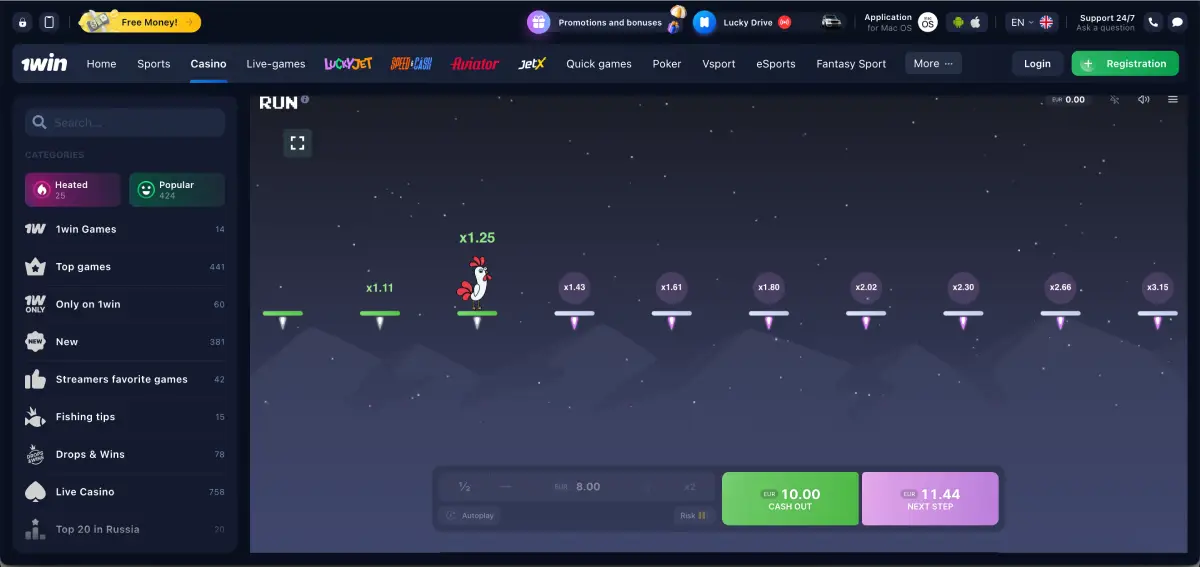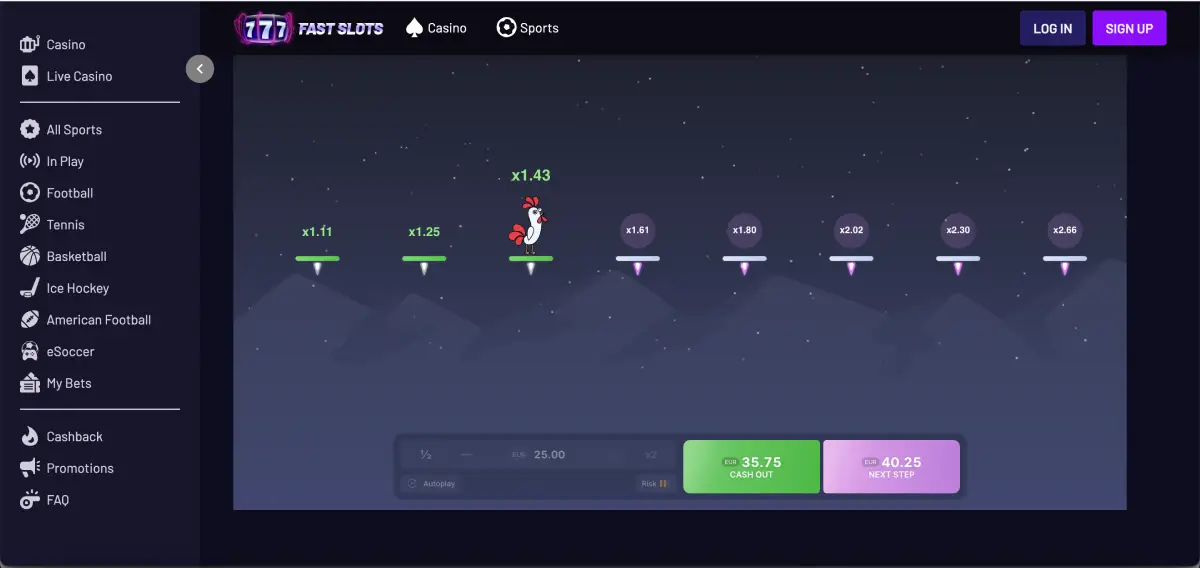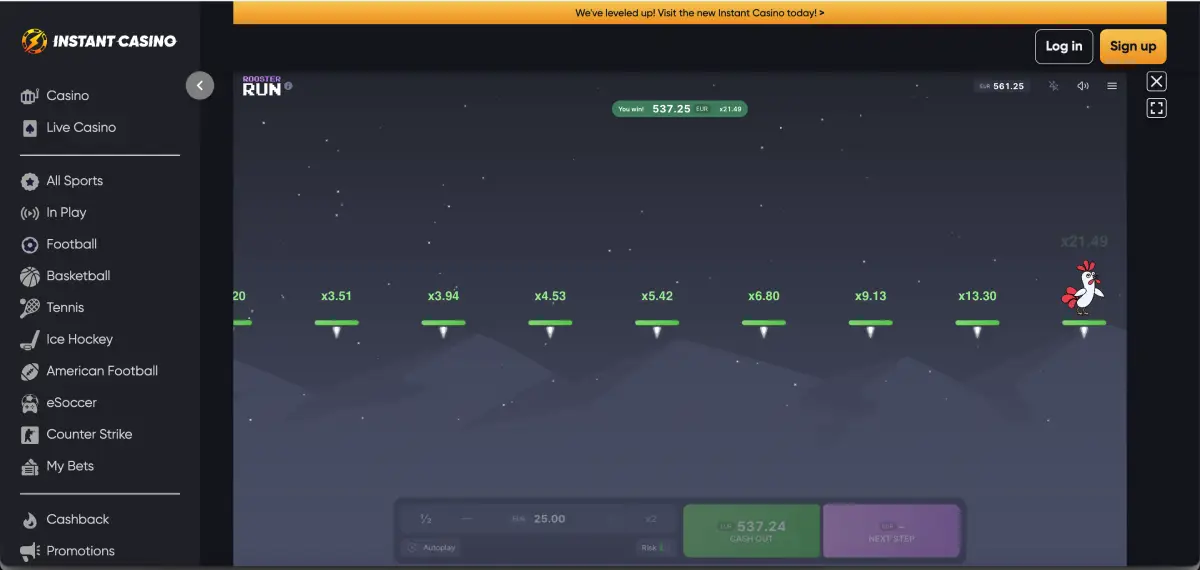Rooster Run by Mascot redefines the crash game concept with a fresh blend of precision, choice, and personality. At the heart of this animated title is a rooster navigating his way across a linear path of multipliers. The twist? Players must decide whether to continue forward or collect their current reward. This isn’t just about watching a graph rise – it’s about decision-making, timing, and adapting to the chosen mode of play.
Rooster Run core concept and structure
Rooster Run abandons the spinning reels in favor of step-based movement. The player watches the rooster hop from one platform to the next, each jump increasing the payout multiplier. A misstep results in a crash and the round ends. The primary goal is to reach the highest multiplier possible without slipping up.
The game interface is clean and minimalistic, focusing attention on the rooster’s movement and the live multiplier value. Unlike traditional crash games with random multiplier spikes, Rooster Run uses controlled progression across visible steps.

Step-by-step vs Instant mode
There are two gameplay styles available:
- Step-by-step: The rooster advances one jump at a time. Players can manually stop the movement at any point to collect the current payout. This allows for mid-round decisions and adds tension with every step.
- Instant: The rooster attempts to reach the target multiplier in one leap. It’s an all-or-nothing move that ends either with a successful high reward or immediate failure.
Each mode serves a different play style. The first suits those who prefer more frequent input and control. The second favors fast sessions and simplified decisions.
Risk levels and volatility control
Before each round, players select a risk level:
- Low: More platforms, lower multipliers, longer progression path.
- Medium: Balanced track length and potential rewards.
- High: Fewer platforms, higher volatility, and maximum multiplier potential up to x10,000.
This choice determines the structure of the current session. The number of steps varies with the setting, which impacts the payout curve and strategy. Low risk offers steadier climbs. High risk compresses the journey into fewer, more intense jumps.
Game specifications
| Feature | Details |
|---|---|
| Title | Rooster Run |
| Developer | Mascot Gaming |
| Type | Crash Game |
| RTP | 95% |
| Max Multiplier | x10,000 |
| Modes | Step-by-step, Instant |
| Volatility Settings | Low, Medium, High |
| Customization | Avatars, themes, interface |
Customization and ranking system
Rooster Run by Mascot introduces a progression layer through its ranking system. Each bet placed in the game adds experience points to the player’s yearly rank. Higher ranks unlock new visual styles for the rooster, interface themes, and unique cosmetic items. This system adds a sense of progression for returning users without interfering with gameplay mechanics or odds.
The customization includes various rooster outfits – ninjas, magicians, farmers – and interface colors. These elements are purely decorative but enhance engagement and identity within the game.

Leaderboards and betting history
Three boards display player activity:
- All Bets: View ongoing bets across the current session.
- Top: Shows highest multipliers and wins over time.
- My Bets: Tracks the player’s personal performance and cashouts.
These boards help players evaluate outcomes, observe multipliers others are achieving, and reflect on their own strategies. It introduces a light social element without requiring direct interaction.
How to play Rooster Run
Step-by-step instructions
- Choose a risk level: Low, Medium, or High.
- Enter your bet amount.
- Select gameplay mode: Step-by-step or Instant.
- If playing step-by-step, click “Forward” to move to the next multiplier.
- Click “Cashout” anytime before the rooster crashes.
- Repeat the cycle with the same or new settings.
Each decision carries tension – stay or jump forward. There are no automatic wins. The design encourages thoughtful pacing and reaction to real-time outcomes.
Strategies for playing Rooster Run
Rooster Run isn’t a mindless tap-and-watch crash title. Each jump is a calculated step that forces players to reassess: is the current multiplier worth taking, or does it make sense to go further?
Here are a few practical strategic approaches players commonly use:
Early cashout strategy
This is often used on high-risk mode. Since the number of steps is small, many aim to secure moderate multipliers (e.g. x2–x5) by exiting early rather than chasing the x10000 top prize. This reduces the chances of losing the entire round on a bad step.
Step count targeting
Some players base their decisions on specific platform counts instead of chasing exact multipliers. For instance, in medium risk mode (25 steps), they may aim to cash out after 10–12 jumps, regardless of the current multiplier, following a strict rule-based method to avoid overreaching.
Incremental progression in autoplay
Using step-by-step autoplay with manual override allows for flexible decisions. Players may let the rooster go through a few platforms automatically and manually step in to cash out when visual cues or gut instinct tell them it’s time.

Targeted instant leaps
In instant mode, many prefer to set a fixed target multiplier and let the game run multiple fast attempts. This strategy suits those who want rapid outcomes and are willing to play the probability game at scale.
Comparison: Rooster Run vs Chicken Road
While both Rooster Run and Chicken Road operate on step-based crash mechanics, their design philosophies differ significantly.
| Feature | Rooster Run | Chicken Road |
|---|---|---|
| Risk levels | Three selectable levels (Low, Medium, High) | Fixed by game version (e.g. Chicken Road 2 is harder) |
| Step logic | Customizable, based on player-selected path | Linear path with random event-based step success |
| Visual style | Minimalist and clean with customizable avatars | Cartoon-style design with occasional animations |
| Game pace | Two distinct modes: Instant and Step-by-step | One consistent pace per round |
| Autoplay system | Advanced, with stop conditions and modes | Basic or unavailable |
| Max multiplier | Up to x10000 | Usually capped lower |
Rooster Run offers more flexibility and control per round. Chicken Road appeals to those who enjoy a visual theme and shorter play sessions, while Rooster Run focuses on sustained engagement and calculated gameplay.
Where to play Rooster Run
Rooster Run is already available at several trusted online platforms. Here are the top picks where the game is live:
- 1win – One of the earliest platforms to offer Rooster Run. Fast withdrawals and regular promotions tied to crash games.
- Fast Slots – Specializes in quick-load arcade and crash titles. Rooster Run fits perfectly into their minimalist layout.
- Instant Casino – A platform known for no-delay gameplay. Here, Rooster Run works seamlessly with both autoplay modes.
- Lucky Star – With a loyalty-based ranking system and themed tournaments, this casino adds extra value to regular Rooster Run sessions.
All of these casinos support both real-money and demo versions of the game, allowing players to explore at their own pace.
Demo mode: play Rooster Run without an account
Every major casino that hosts Rooster Run also offers a demo version that doesn’t require registration. This mode is identical in mechanics to the real-money version, but uses virtual currency instead of real bets.
Why use demo mode?
- Understand how each risk tier changes the number of steps.
- Try both gameplay modes (step-by-step and instant).
- Practice cashout timing without pressure.
- Observe how the multipliers scale across rounds.
Demo access is available instantly on platforms like 1win, Instant Casino, and Lucky Star. No email or phone number needed — just launch the game and start playing.
![]()
Final thoughts on Rooster Run by Mascot
Rooster Run brings a deliberate, step-based twist to the crash genre. With selectable volatility tiers, visual customization, and a live leaderboard system, the game manages to carve out a unique identity without relying on clutter or gimmicks. The two gameplay styles – manual and instant – allow players to pick the pace that suits them best.
This is a game for those who enjoy straightforward decisions with direct consequences. The path to a x10,000 payout is not hidden behind layers of effects or bonus wheels – it’s visible, structured, and based on the player’s own judgment.
Rooster Run by Mascot avoids bloated visuals and instead offers a sharp focus on risk, progression, and timing. It’s an engaging crash format for players who like their games simple in interface but deep in decision-making.

